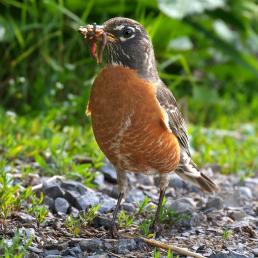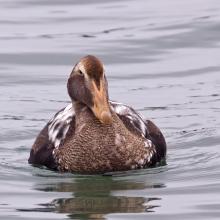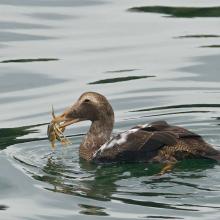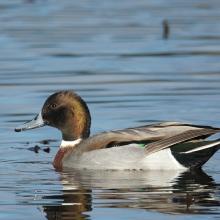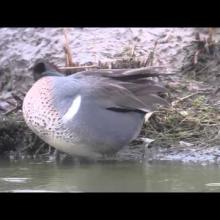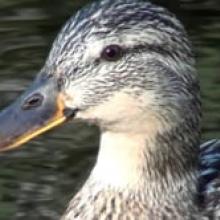

Join BirdNote tomorrow, November 30th!
Illustrator David Sibley and actor H. Jon Benjamin will face off in the bird illustration battle of the century during BirdNote's Year-end Celebration and Auction!
Ducks that start laying eggs soon after arriving at a suitable nest site are sometimes called “capital” breeders, because they carry with them, in their bodies, all the food and fat reserves they need to begin nesting when they arrive. “Income” breeders arrive at their nesting sites after a long migration, hungry and ready to chow down. It’s only after the female has gained enough of a nutrient “income” that she’ll be ready to lay her first clutch of eggs. Mallards — like the female seen here — may have enough energy stored up to lay a first clutch of eggs.
BirdNote®
Big Ducks, Small Ducks, and the Economy of Nesting
Written by Bob Sundstrom
This is BirdNote.
[ducks quacking and splashing, https://www.youtube.com/watch?v=9oIsl33DnlA , 1.08-1.12]
There’s a lot of commotion in late winter. The ducks are selecting their mates.
[quack quack]
These newly formed pairs will migrate back north together in the spring.
[Common Eider call, https://macaulaylibrary.org/asset/4105, 0.05-.10]
Large species of ducks, such as the four-pound Common Eider, will start laying eggs soon after arriving at a suitable nest site. These ducks are sometimes called “capital” breeders, because they carry with them, in their bodies, all the food and fat reserves they need to begin nesting when they arrive.
[Green-winged Teal call, https://macaulaylibrary.org/asset/118551671, 0.02-.07]
And then there are the “income” breeders, like the Green-winged Teal. These smaller ducks weigh about a pound or less. They arrive at their nesting sites, after a long migration, hungry and ready to chow down. They’re eager for foods that are rich in calcium and protein, like seeds or small invertebrates like worms. It’s only after the female has gained enough of a nutrient “income” that she’ll be ready to lay her first clutch of eggs.
Mid-sized ducks, like the three-pound Mallard, may have enough energy stored up to lay a first clutch of eggs, but they’ll be looking to refuel soon after.
Just how taxing is it on a female duck to lay a clutch of eggs? To put it in human terms, it would be like a woman giving birth to an eight-pound baby once a day… for NINE TO TEN DAYS.
For BirdNote, I’m Michael Stein.
###
Bird sounds provided by The Macaulay Library of Natural Sounds at the Cornell Lab of Ornithology, Ithaca, New York. Recorded by S Palmer ML4105; T Floyd ML118551671; AA Allen ML 3429.
BirdNote’s theme composed and played by Nancy Rumbel and John Kessler.
Producer: John Kessler; Managing Producer: Jason Saul; Associate Producer: Ellen Blackstone
© 2019 Tune In to Nature.org February 2019 Narrator: Michael Stein
ID# egg-05-2019-02-18 egg-05
Quote and energy information from
https://www.ducks.ca/stories/waterfowl/a-duck-in-spring/
See also https://sora.unm.edu/sites/default/files/journals/nabb/v024n02/p0038-p0…
https://pdfs.semanticscholar.org/2eb5/d02d76f585c05b07a14336462a793b723…
